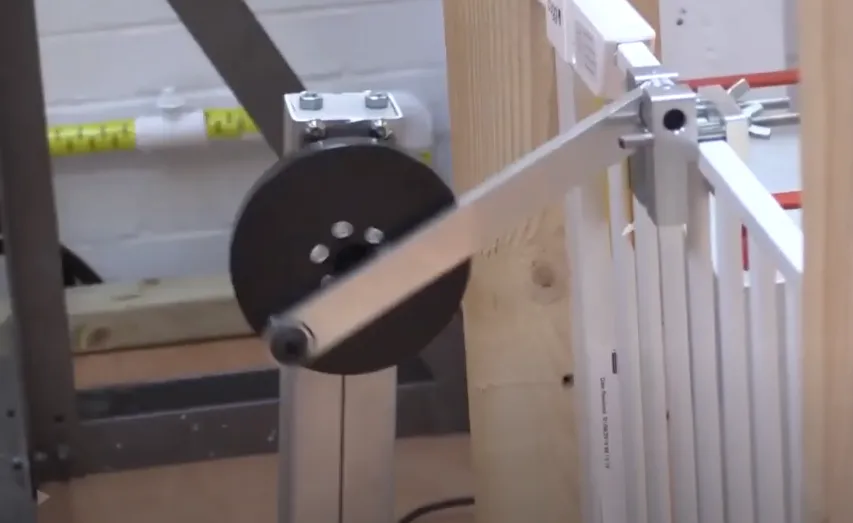DIN EN 12227 Playpens Durability and Strength Testing
The DIN EN 12227 standard is a European norm that specifies the requirements for playpens designed to ensure children's safety. This standard is particularly important as it addresses durability, strength, and stability of playpens used in homes with young children. Compliance with this standard ensures that products are robust enough to withstand typical use, yet secure against potential hazards such as structural collapse or component detachment.
Children’s furniture plays a crucial role in their development. Playpens provide a safe space for infants and toddlers to explore while parents can perform household tasks nearby. However, the durability and strength of these products are critical factors that cannot be compromised. The standard establishes detailed test procedures to evaluate key aspects such as structural integrity under load, impact resistance, and overall stability.
The testing process involves subjecting playpen frames and components to various simulated real-world scenarios. For instance, a load is applied to the frame to assess its ability to withstand static and dynamic loads without compromising safety or stability. This ensures that the product can endure typical stressors like a child climbing in and out of the pen over time.
Another critical aspect tested under DIN EN 12227 is impact resistance. The standard specifies specific impact scenarios, such as dropping heavy objects onto the frame to simulate accidental impacts from household items. This testing helps ensure that playpens can maintain their structural integrity and do not pose a risk of collapse or component failure.
Stability tests also form an integral part of this standard. These tests aim to evaluate how well a playpen resists tipping over under various conditions, including when children are inside the pen. The stability criteria are designed to prevent accidents that could result in injury if the structure were to tip or collapse unexpectedly.
Compliance with DIN EN 12227 is mandatory for manufacturers selling their products within Europe and other regions adhering to this standard. The stringent testing requirements ensure that playpen manufacturers adhere to high safety standards, providing parents peace of mind knowing they are purchasing safe products.
Applied Standards
| Standard | Description |
|---|---|
| DIN EN 12227:2019-03 | This standard specifies the requirements and test methods for playpens designed to ensure children's safety. It covers aspects such as structural integrity, impact resistance, stability, and durability. |
| ISO 846:1997 | International standard related to infant bedding products that complements DIN EN 12227 by providing additional guidance on design and materials for infant sleep environments. |
Quality and Reliability Assurance
The testing procedures outlined in DIN EN 12227 are crucial for ensuring the quality and reliability of playpens. By adhering to these standards, manufacturers can demonstrate their commitment to producing safe products that meet regulatory requirements.
Compliance with this standard involves rigorous testing at every stage of product development. Quality managers and R&D engineers ensure that each component meets not only the specified criteria but also undergoes additional internal quality checks. This comprehensive approach helps identify any potential issues early in the design phase, allowing for timely corrections before mass production begins.
For procurement teams involved in sourcing materials and components used in playpen manufacturing, compliance with DIN EN 12227 sets a benchmark for suppliers to meet. This ensures that all parts are of high quality and consistently reliable, contributing to the overall safety and durability of the final product.
The testing process itself is conducted by accredited laboratories equipped with state-of-the-art instrumentation capable of replicating real-world conditions accurately. Skilled technicians perform these tests meticulously, ensuring accurate results reflective of actual use scenarios. The data collected during testing provides valuable insights into the performance characteristics of each playpen model, enabling continuous improvement in future iterations.
In summary, compliance with DIN EN 12227 plays a vital role in maintaining high standards of quality and reliability within the industry. It fosters trust among consumers while promoting innovation through stringent yet fair testing protocols.
Environmental and Sustainability Contributions
The implementation of DIN EN 12227 not only enhances product safety but also contributes positively to environmental sustainability. By focusing on durability and strength, manufacturers can extend the lifecycle of playpens, reducing waste generation associated with frequent replacement due to poor quality.
Manufacturers who adhere to this standard are encouraged to adopt sustainable practices throughout their supply chain, from raw material sourcing to end-of-life disposal options. For instance, using recycled materials or ensuring easy disassembly for recycling at the end of a product's life cycle can significantly reduce environmental impact.
The durability aspect of DIN EN 12227 also promotes resource efficiency by encouraging manufacturers to design products that last longer without compromising safety or performance. This approach reduces the need for frequent replacements, thereby conserving natural resources and minimizing waste sent to landfills.
Furthermore, compliance with this standard can lead to cost savings for both manufacturers and consumers over time. Longer-lasting playpens require fewer replacements, which translates into reduced costs for parents purchasing these products. For manufacturers, maintaining high standards ensures better brand reputation and customer loyalty, potentially increasing long-term profitability.
In conclusion, DIN EN 12227 contributes significantly to environmental sustainability by promoting durable design practices that enhance product longevity while ensuring safety remains paramount.





